高效阅读材料2
专题16 非连续性文本阅读(二)-2024年小升初语文考点精准练(统编版)
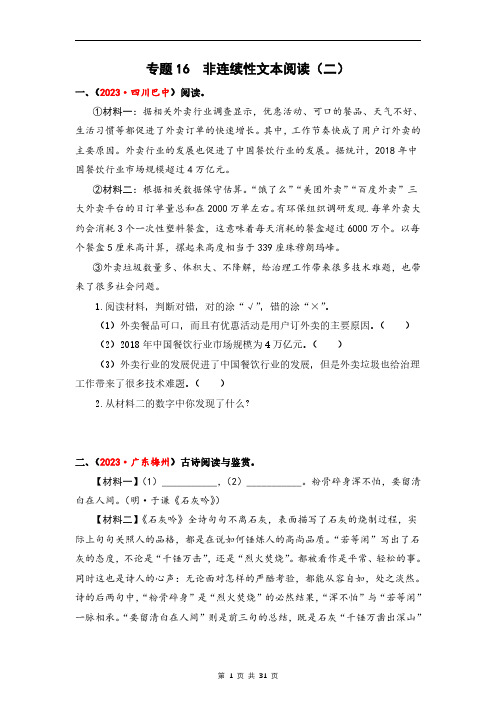
专题16非连续性文本阅读(二)一、(2023·四川巴中)阅读。
①材料一:据相关外卖行业调查显示,优惠活动、可口的餐品、天气不好、生活习惯等都促进了外卖订单的快速增长。
其中,工作节奏快成了用户订外卖的主要原因。
外卖行业的发展也促进了中国餐饮行业的发展。
据统计,2018年中国餐饮行业市场规模超过4万亿元。
②材料二:根据相关数据保守估算。
“饿了么”“美团外卖”“百度外卖”三大外卖平台的日订单量总和在2000万单左右。
有环保组织调研发现.每单外卖大约会消耗3个一次性塑料餐盒,这意味着每天消耗的餐盒超过6000万个。
以每个餐盒5厘米高计算,摞起来高度相当于339座珠穆朗玛峰。
③外卖垃圾数量多、体积大、不降解,给治理工作带来很多技术难题,也带来了很多社会问题。
1.阅读材料,判断对错,对的涂“√”,错的涂“×”。
(1)外卖餐品可口,而且有优惠活动是用户订外卖的主要原因。
()(2)2018年中国餐饮行业市场规模为4万亿元。
()(3)外卖行业的发展促进了中国餐饮行业的发展,但是外卖垃圾也给治理工作带来了很多技术难题。
()2.从材料二的数字中你发现了什么?二、(2023·广东梅州)古诗阅读与鉴赏。
【材料一】(1)___________,(2)___________。
粉骨碎身浑不怕,要留清白在人间。
(明·于谦《石灰吟》)【材料二】《石灰吟》全诗句句不离石灰,表面描写了石灰的烧制过程,实际上句句关照人的品格,都是在说如何锤炼人的高尚品质。
“若等闲”写出了石灰的态度,不论是“千锤万击”,还是“烈火焚烧”。
都被看作是平常、轻松的事。
同时这也是诗人的心声:无论面对怎样的严酷考验,都能从容自如,处之淡然。
诗的后两句中,“粉骨碎身”是“烈火焚烧”的必然结果,“浑不怕”与“若等闲”一脉相承。
“要留清白在人间”则是前三句的总结,既是石灰“千锤万凿出深山”“烈火焚烧若等闲”“粉骨碎身浑不怕”的根本原因,也是诗人决不与世俗同流合污的誓言。
3.2 议论文主题阅读2【2024湖北新中考语文新题型高效训练】(解析版)

3.2议论文主题阅读2主题三传统文化六、(2023 辽宁盘锦)阅读下面文章,完成1~5题。
(15分)对接教材:同主题·七下第四单元“修身正己”话题新:三大文化·中华优秀传统文化阅读量:996字今天我们需要什么样的礼乐文化殷慧①“乐者,天地之和也;礼者,天地之序也。
”礼乐文化是中华文明的根基与灵魂。
北京冬奥会开幕盛典上,雪花飞舞,火炬点燃,烟花绽放,中国向世界张开热烈的臂膀,当冰雪之约如约而至的那一刻,我们激动万分。
这场盛大庄严、气势恢宏的仪式,彰显着中国礼乐文化的魅力。
新的时代环境下,中华礼乐文化需要与现代人的生活相适应,与社会主义核心价值观相契合。
②礼乐文化在现代社会有重要的精神价值和时代意义。
礼乐文化增强人们的认同感和归属感。
去年全国“七一勋章”颁授仪式上,红毯铺道,红旗漫卷,被待以“国家最高礼遇”的英雄们前往人民大会堂,登上授勋台的那一刻,我们百感交集,为自己的英雄自豪,也为生活在英雄的国度而骄傲。
礼乐文化促进社会和谐与发展。
在古代,礼乐文化是庙堂之上的“阳春白雪”,普通百姓只能对其“敬而远之”。
现代社会,我们要让礼乐文化走近普通百姓,引导普通人将礼乐文化内化于心,外化于行。
我们可以利用重大纪念日、民族传统节日,组织开展形式多样的纪念庆典活动,传播主流价值,让百姓知礼、懂礼、用礼,营造更为和谐美好的社会局面。
③为满足现代人的需求,我们要推动传统礼乐文化创新性发展。
学校和媒体在创新方面发挥了重大作用。
近些年,一些学校开发了大量现代礼仪课程,受到学生和社会人士的热烈欢迎。
媒体方面,山东广播电视台推出全国首档中华礼乐传习系列节目,如《尊师礼》篇,设计了“正冠、献桃枝、敬茶、训诫、赠书”等现代师徒礼仪;《成人礼》篇,从花木兰从军出征保家卫国,讲到排爆英雄张保国的女儿张汝佳女承父志选择当警察,让人看到“爱国敬业”等价值观念贯通古今。
④当然,一提起礼乐文化,一些人可能会想到“克己复礼”“三纲五常”“男尊女卑”,这些都是传统礼乐文化中的消极内容。
书香高效阅读之表达方法(二)ok
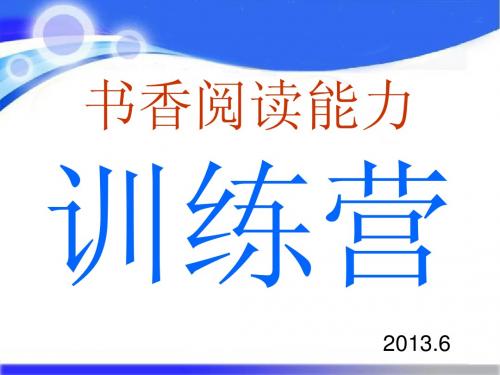
1.结合短文,解释文中词语的含义。 嚣张:———————————————————— 泪眼盈盈:———————————————————— —————— 2.文中承上启下的句子是哪句? 3.用一句话概括第三至七自然段的内容。 4.文中的“鞋”是一双怎样的鞋?用波浪线在文中画出 描写这双鞋的句子。谈谈“我”为什么舍不得丢弃这双 鞋。 5.文中有两处描写外婆神态的地方,请你找出来,写一 写。 6.“外婆去世息传来以后”,“我”的心情怎样,请写 一段文字描述出来。 7.“那么遥远,那么温柔,而又那么肯定地一去不复 返”。这是一句意味深长的话,说说你的理解。
三、学习托物言志,借物喻理,在具体的 事实描述中说明道理的方法。 两种写法不同在于“志”和“理”的差别。 “志”多言及个人情感,坦露快活与忧闷。 “理”重在道理,通过对事物的描写来阐 明客观存在的事理。 如何感悟并表达文章的思想感情?
(1)依据文章的主要内容,体会作者的思想感情。 (2)依据带有感情色彩的语句,体会作者的思想感情。 (3)依据含义深刻的语句、段落,体会文章的思想感情。 (4)在反复朗读中体会文章的思想感情。
二、学习抒情的方法 叙事抒情、借景抒情 作者对某个景象或某种客观事物有所感触 时,会把自身所要抒发的感情、表达的思 想寄寓在此景此物中,通过描写此景此物 予以抒发。这种抒情方式就叫借景或借物 抒情。这是一种间接而含蓄的抒情方式。 直接抒情一般适用于抒发强烈而紧张的感 情。特点是叙述时感情强烈,节奏快、紧 张,情感直露,读者容易把握。
1.第五自然段中“再次反击”照应的是前文 的哪一句? 2.第六自然段中“地球逐渐降温“一句中, 为什么要用“逐渐”一词?请在本段中 找出依据。 3.本文采用的说明顺序是————,表是 这种顺序的词语有————————— — 4.本文说明的主要内容是什么?
2.2 说明文主题阅读2【2024湖北新中考语文新题型高效训练】(解析版)
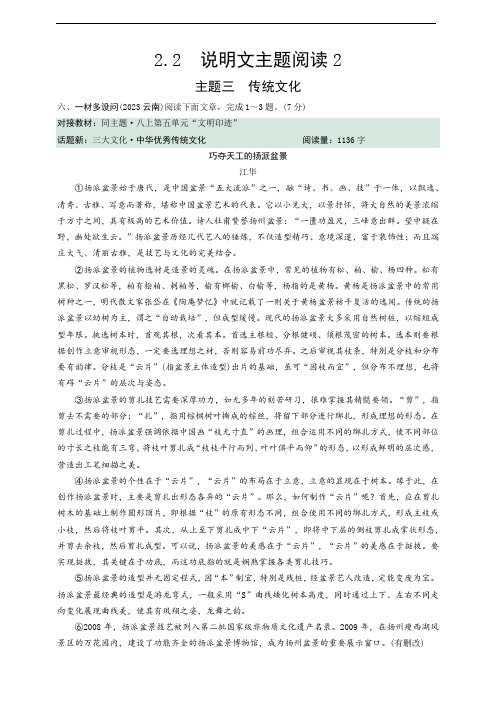
2.2 说明文主题阅读2主题三传统文化六、一材多设问(2023云南)阅读下面文章,完成1~3题。
(7分)对接教材:同主题·八上第五单元“文明印迹”话题新:三大文化·中华优秀传统文化阅读量:1136字巧夺天工的扬派盆景江华①扬派盆景始于唐代,是中国盆景“五大流派”之一,融“诗、书、画、技”于一体,以飘逸、清秀、古雅、写意而著称,堪称中国盆景艺术的代表。
它以小见大,以景抒怀,将大自然的美景浓缩于方寸之间,具有极高的艺术价值。
诗人杜甫赞誉扬州盆景:“一匮功盈尺,三峰意出群。
望中疑在野,幽处欲生云。
”扬派盆景历经几代艺人的锤炼,不仅造型精巧、意境深邃,富于装饰性;而且端庄大气、清丽古雅,是技艺与文化的完美结合。
②扬派盆景的植物选材是造景的灵魂。
在扬派盆景中,常见的植物有松、柏、榆、杨四种。
松有黑松、罗汉松等,柏有桧柏、刺柏等,榆有榔榆、白榆等,杨指的是黄杨。
黄杨是扬派盆景中的常用树种之一,明代散文家张岱在《陶庵梦忆》中就记载了一则关于黄杨盆景枯干复活的逸闻。
传统的扬派盆景以幼树为主,谓之“自幼栽培”,但成型缓慢。
现代的扬派盆景大多采用自然树桩,以缩短成型年限。
挑选树本时,首观其根,次看其本。
首选主根短、分根健硕、须根茂密的树本。
选本则要根据创作立意审视形态,一定要选理想之材,否则容易前功尽弃。
之后审视其枝条,特别是分枝和分布要有韵律。
分枝是“云片”(指盆景主体造型)出片的基础,虽可“因枝而宜”,但分布不理想,也将有碍“云片”的层次与姿态。
③扬派盆景的剪扎技艺需要深厚功力,如无多年的刻苦研习,很难掌握其精髓要领。
“剪”,指剪去不需要的部分;“扎”,指用棕榈树叶撕成的棕丝,将留下部分进行绑扎,形成理想的形态。
在剪扎过程中,扬派盆景强调依据中国画“枝无寸直”的画理,组合运用不同的绑扎方式,使不同部位的寸长之枝能有三弯,将枝叶剪扎成“枝枝平行而列、叶叶俱平而仰”的形态,以形成鲜明的层次感,营造出工笔细描之美。
托福TPO34阅读Passage2原文文本+题目+答案解析
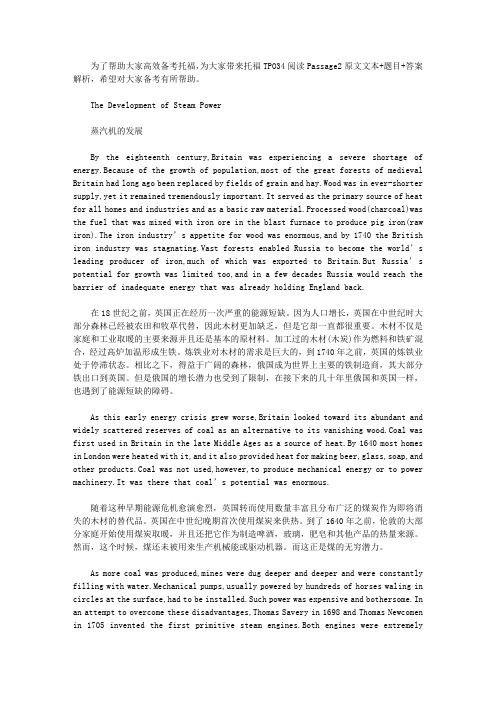
为了帮助大家高效备考托福,为大家带来托福TPO34阅读Passage2原文文本+题目+答案解析,希望对大家备考有所帮助。
The Development of Steam Power 蒸汽机的发展 By the eighteenth century,Britain was experiencing a severe shortage of energy.Because of the growth of population,most of the great forests of medieval Britain had long ago been replaced by fields of grain and hay.Wood was in ever-shorter supply,yet it remained tremendously important.It served as the primary source of heat for all homes and industries and as a basic raw material.Processed wood(charcoal)was the fuel that was mixed with iron ore in the blast furnace to produce pig iron(raw iron).The iron industry’s appetite for wood was enormous,and by 1740 the British iron industry was stagnating.Vast forests enabled Russia to become the world’s leading producer of iron,much of which was exported to Britain.But Russia’s potential for growth was limited too,and in a few decades Russia would reach the barrier of inadequate energy that was already holding England back. 在18世纪之前,英国正在经历一次严重的能源短缺。
实用类文本阅读高效素能提升15-2
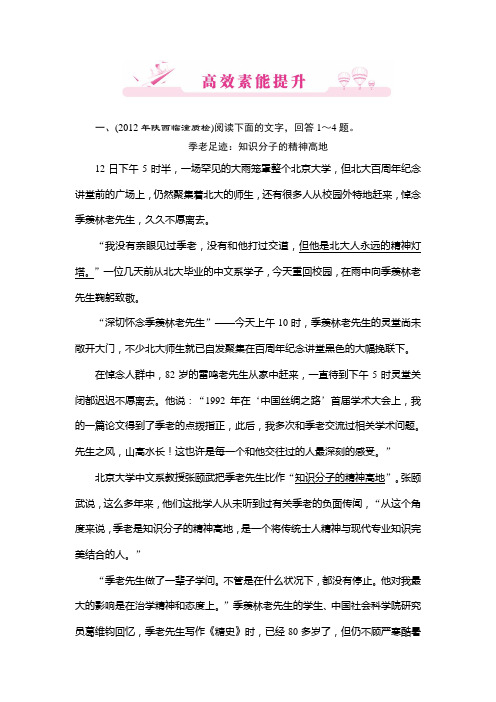
一、(2012年陕西临潼质检)阅读下面的文字,回答1~4题。
季老足迹:知识分子的精神高地12日下午5时半,一场罕见的大雨笼罩整个北京大学,但北大百周年纪念讲堂前的广场上,仍然聚集着北大的师生,还有很多人从校园外特地赶来,悼念季羡林老先生,久久不愿离去。
“我没有亲眼见过季老,没有和他打过交道,但他是北大人永远的精神灯塔。
”一位几天前从北大毕业的中文系学子,今天重回校园,在雨中向季羡林老先生鞠躬致敬。
“深切怀念季羡林老先生”——今天上午10时,季羡林老先生的灵堂尚未敞开大门,不少北大师生就已自发聚集在百周年纪念讲堂黑色的大幅挽联下。
在悼念人群中,82岁的雷鸣老先生从家中赶来,一直待到下午5时灵堂关闭都迟迟不愿离去。
他说:“1992年在‘中国丝绸之路’首届学术大会上,我的一篇论文得到了季老的点拨指正,此后,我多次和季老交流过相关学术问题。
先生之风,山高水长!这也许是每一个和他交往过的人最深刻的感受。
”北京大学中文系教授张颐武把季老先生比作“知识分子的精神高地”。
张颐武说,这么多年来,他们这批学人从未听到过有关季老的负面传闻,“从这个角度来说,季老是知识分子的精神高地,是一个将传统士人精神与现代专业知识完美结合的人。
”“季老先生做了一辈子学问。
不管是在什么状况下,都没有停止。
他对我最大的影响是在治学精神和态度上。
”季羡林老先生的学生、中国社会科学院研究员葛维钧回忆,季老先生写作《糖史》时,已经80多岁了,但仍不顾严寒酷暑每天到图书馆查阅资料。
“有时,季老发现了新线索就兴高采烈起来。
他的喜怒哀乐都是和做学问联系在一起的。
”“先生个性极为鲜明,广被万物的爱心与知识分子的胆识在季老先生那里体现得十分醒目。
如果来访者不学无术而又滔滔不绝,先生就会面色木讷长久不言;如果是清纯学生求访解惑,则他每次必从家中送出来直到大门口默默挥手告别。
”北京大学中文系博士生导师王岳川教授告诉记者,“季老生前说过,他最喜欢的知识分子是:质朴,淳厚,诚恳,平易;怀真情,讲真话;关键是一个‘真’字,是性情中人;最高水平当是孟子说的‘富贵不能淫,贫贱不能移,威武不能屈’,这正是夫子自道!”“季羡林老先生为人所敬仰,不仅因为他的学识,更因为他的品格。
(完整word版)全新版大学英语快速阅读2第一单元翻译
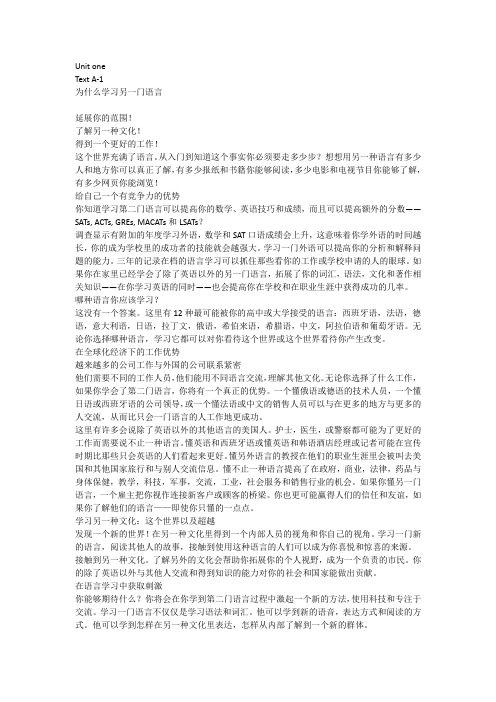
1、频繁的进行英语实验。首先阅读的英语课本,然后听和看一起,然后只听不看。说出或写下你刚刚听到的。
2、在班里当其他同学说的时候静静的听。注意这个作业,不要担心你会做。
3、如果你感到紧张,通过休息一下和深呼吸来放松自己的身体。当你被叫到时,暂停,放松,给自己一个准备的反应。
4、练习:参加语言俱乐部,看外国电视,听外语收音。
最有效的学习是你的积极而不是消极。一个消极的过程(就像看电视)得到的很少甚至在你的部分里没有功能,信息也会很快忘记。在积极学习时,你的关注度会达到最高,使你完全理解整个话题。高效学习让你在学习过程中成为一个积极的参与者。
这里有许多方法和技巧可以让你成长为一个积极学习的人。下面是一些建议。
通过浏览课本的章节预习课程材料来了解主题和思想。问自己一些问题,然后在你阅读的时候做笔记(用自己的话)。这将意味着你在讲师讨论之前抓住了文章的主要材料。
阅读技巧
1、首先,为完成任务而阅读词汇清单。然后关于文章带着问题去读。然后看整篇文章两到三遍,通过上下文猜测文章的含义。避免逐词的翻译。这是浪费时间。
2、把新词汇分离出来单独学习。不要在写在行之间!做一个新的单词卡然后记住它。带着他们然后在每天的零碎的时间背诵。学习他们直到你能自动记住。
3、分离新的语法然后单独学习。写下和标记例句。当你阅读到面对这个模式时,暂停下然后背诵这个模板来认出来。
Unitone
Text A-1
为什么学习另一门语言
延展你的范围!
了解另一种文化!
得到一个更好的工作!
这个世界充满了语言。从入门到知道这个事实你必须要走多少步?想想用另一种语言有多少人和地方你可以真正了解,有多少了解,有多少网页你能浏览!
给自己一个有竞争力的优势
二年级高效阅读题二
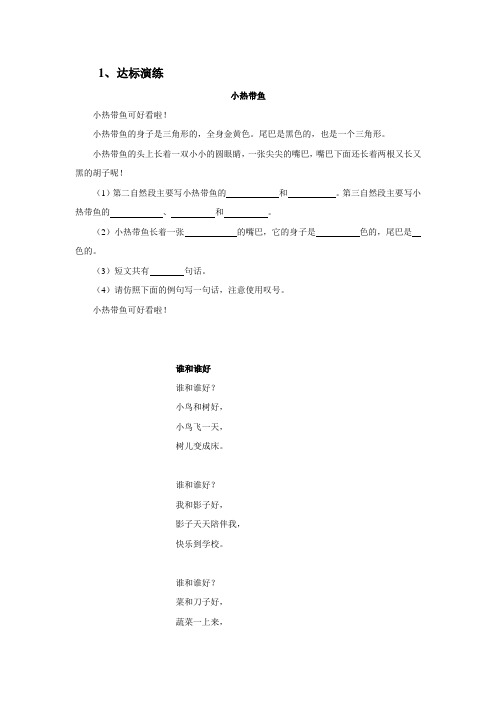
1、达标演练小热带鱼小热带鱼可好看啦!小热带鱼的身子是三角形的,全身金黄色。
尾巴是黑色的,也是一个三角形。
小热带鱼的头上长着一双小小的圆眼睛,一张尖尖的嘴巴,嘴巴下面还长着两根又长又黑的胡子呢!(1)第二自然段主要写小热带鱼的和。
第三自然段主要写小热带鱼的、和。
(2)小热带鱼长着一张的嘴巴,它的身子是色的,尾巴是色的。
(3)短文共有句话。
(4)请仿照下面的例句写一句话,注意使用叹号。
小热带鱼可好看啦!谁和谁好谁和谁好?小鸟和树好,小鸟飞一天,树儿变成床。
谁和谁好?我和影子好,影子天天陪伴我,快乐到学校。
谁和谁好?菜和刀子好,蔬菜一上来,刀子就舞蹈。
谁和谁好?妈妈和爸爸好,天天在一起,从来不吵闹。
(1)诗中的小鸟和好,我和好,菜和好,妈妈和好。
(2)第一小节有句话。
(3)作者的诗写得太美了,你也照样子写一节,注意要用上问号。
(4)用“”画出带问号的句子。
2、综合能力提升和太阳比赛跑当森林和鲜花还在沉睡,当小鸟和白兔还在梦里,我们离开帐篷,轻轻地走过他们身边。
别怕,我们不会打扰你,我们是和太阳比赛早起!我们穿过树林,跨过小溪,沿着小路,奔上山顶。
你看,东方的云彩在变颜色,云彩呀,是不是比不过我们,你才脸红?别嚷!太阳露出头顶了,太阳露出眉毛和眼睛了,太阳露出笑脸了!太阳跳起来了!花草树木一下子都睁开眼睛,唱着歌,摇动着手臂。
小鸟向四面八方报信。
太阳升起来了!太阳升起来了!啊,亲爱的朋友们,放开嗓子,唱起来吧!让我们尽情欢呼祖国的早晨,迎接这更美好的一天!(1)照样子填写词语:例:穿过树林()小溪()手臂()笑脸()眼睛()嗓子()山顶(2)从哪些词句看出“我们是和太阳比赛早起”?用横线画出有关的句子。
(3)诗歌中用了许多的感叹号,你能通过朗读表现出来吗?和同学开展比赛吧!春到校园春天来了,花儿开了,草儿绿了,我们的校园真美丽。
美在哪里呢?教学楼前摆放着五颜六色的鲜花。
有玫瑰、月季,还有郁金香,姿态各异,真美丽。
托福TPO2阅读Passage2原文文本+题目+答案解析

为了帮助大家高效备考托福,为大家带来托福TPO2阅读Passage2原文文本+题目+答案解析,希望对大家备考有所帮助。
▉托福TPO2阅读Passage2原文文本: The Origins of Cetaceans It should be obvious that cetaceans-whales, porpoises, and dolphins-are mammals. They breathe through lungs, not through gills, and give birth to live young. Their streamlined bodies, the absence of hind legs, and the presence of a fluke and blowhole cannot disguise their affinities with land dwelling mammals. However, unlike the cases of sea otters and pinnipeds (seals, sea lions, and walruses, whose limbs are functional both on land and at sea), it is not easy to envision what the first whales looked like. Extinct but already fully marine cetaceans are known from the fossil record. How was the gap between a walking mammal and a swimming whale bridged? Missing until recently were fossils clearly intermediate, or transitional, between land mammals and cetaceans. Very exciting discoveries have finally allowed scientists to reconstruct the most likely origins of cetaceans. In 1979, a team looking for fossils in northern Pakistan found what proved to be the oldest fossil whale. The fossil was officially named Pakicetus in honor of the country where the discovery was made. Pakicetus was found embedded in rocks formed from river deposits that were 52 million years old. The river that formed these deposits was actually not far from an ancient ocean known as the Tethys Sea. The fossil consists of a complete skull of an archaeocyte, an extinct group of ancestors of modern cetaceans. Although limited to a skull, the Pakicetus fossil provides precious details on the origins of cetaceans. The skull is cetacean-like but its jawbones lack the enlarged space that is filled with fat or oil and used for receiving underwater sound in modern whales. Pakicetus probably detected sound through the ear opening as in land mammals. The skull also lacks a blowhole, another cetacean adaptation for diving. Other features, however, show experts that Pakicetus is a transitional form between a group of extinct flesh- eating mammals, the mesonychids, and cetaceans. It has been suggested that Pakicetus fed on fish in shallow water and was not yet adapted for life in the open ocean. It probably bred and gave birth on land. Another major discovery was made in Egypt in 1989. Several skeletons of another early whale, Basilosaurus, were found in sediments left by the Tethys Sea and now exposed in the Sahara desert. This whale lived around 40 million years ago, 12 million years after Pakicetus. Many incomplete skeletons were found but they included, for the first time in an archaeocyte, a complete hind leg that features a foot with three tiny toes. Such legs would have been far too small to have supported the 50-foot-longBasilosaurus on land. Basilosaurus was undoubtedly a fully marine whale with possibly nonfunctional, or vestigial, hind legs. An even more exciting find was reported in 1994, also from Pakistan. The now extinct whale Ambulocetus natans ("the walking whale that swam") lived in the Tethys Sea 49 million years ago. It lived around 3 million years after Pakicetus but 9 million before Basilosaurus. The fossil luckily includes a good portion of the hind legs. The legs were strong and ended in long feet very much like those of a modern pinniped. The legs were certainly functional both on land and at sea. The whale retained a tail and lacked a fluke, the major means of locomotion in modern cetaceans. The structure of the backbone shows, however, that Ambulocetus swam like modern whales by moving the rear portion of its body up and down, even though a fluke was missing. The large hind legs were used for propulsion in water. On land, where it probably bred and gave birth, Ambulocetus may have moved around very much like a modern sea lion. It was undoubtedly a whale that linked life on land with life at sea. ▉托福TPO2阅读Passage2题目: Question 1 of 13 In paragraph 1, what does the author say about the presence of a blowhole in cetaceans? A. It clearly indicates that cetaceans are mammals.. B. It cannot conceal the fact that cetaceans are mammals.. C. It is the main difference between cetaceans and land-dwelling mammals.. D. It cannot yield clues about the origins of cetaceans.. Question 2 of 13 Which of the following can be inferred from paragraph 1 about early sea otters? A. It is not difficult to imagine what they looked like.. B. There were great numbers of them.. C. They lived in the sea only.. D. They did not leave many fossil remains.. uestion 3 of 13。
托福TPO11阅读Passage2原文文本+题目+答案解析
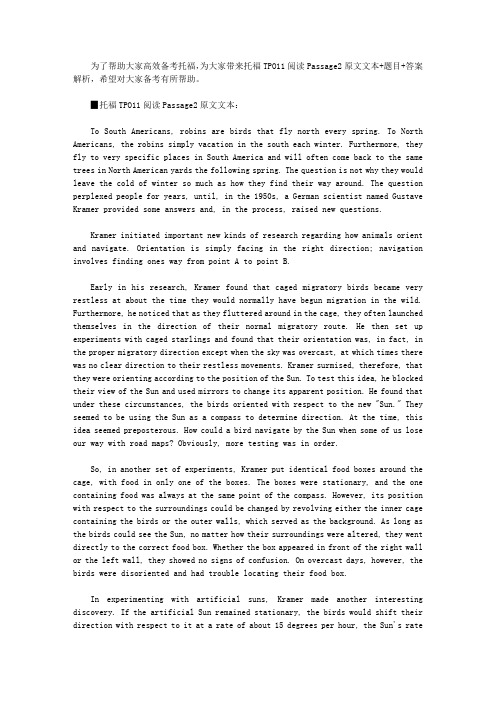
为了帮助大家高效备考托福,为大家带来托福TPO11阅读Passage2原文文本+题目+答案解析,希望对大家备考有所帮助。
▉托福TPO11阅读Passage2原文文本: To South Americans, robins are birds that fly north every spring. To North Americans, the robins simply vacation in the south each winter. Furthermore, they fly to very specific places in South America and will often come back to the same trees in North American yards the following spring. The question is not why they would leave the cold of winter so much as how they find their way around. The question perplexed people for years, until, in the 1950s, a German scientist named Gustave Kramer provided some answers and, in the process, raised new questions. Kramer initiated important new kinds of research regarding how animals orient and navigate. Orientation is simply facing in the right direction; navigation involves finding ones way from point A to point B. Early in his research, Kramer found that caged migratory birds became very restless at about the time they would normally have begun migration in the wild. Furthermore, he noticed that as they fluttered around in the cage, they often launched themselves in the direction of their normal migratory route. He then set up experiments with caged starlings and found that their orientation was, in fact, in the proper migratory direction except when the sky was overcast, at which times there was no clear direction to their restless movements. Kramer surmised, therefore, that they were orienting according to the position of the Sun. To test this idea, he blocked their view of the Sun and used mirrors to change its apparent position. He found that under these circumstances, the birds oriented with respect to the new "Sun." They seemed to be using the Sun as a compass to determine direction. At the time, this idea seemed preposterous. How could a bird navigate by the Sun when some of us lose our way with road maps? Obviously, more testing was in order. So, in another set of experiments, Kramer put identical food boxes around the cage, with food in only one of the boxes. The boxes were stationary, and the one containing food was always at the same point of the compass. However, its position with respect to the surroundings could be changed by revolving either the inner cage containing the birds or the outer walls, which served as the background. As long as the birds could see the Sun, no matter how their surroundings were altered, they went directly to the correct food box. Whether the box appeared in front of the right wall or the left wall, they showed no signs of confusion. On overcast days, however, the birds were disoriented and had trouble locating their food box. In experimenting with artificial suns, Kramer made another interesting discovery. If the artificial Sun remained stationary, the birds would shift their direction with respect to it at a rate of about 15 degrees per hour, the Sun's rateof movement across the sky. Apparently, the birds were assuming that the "Sun" they saw was moving at that rate. When the real Sun was visible, however, the birds maintained a constant direction as it moved across the sky. In other words, they were able to compensate for the Sun's movement. This meant that some sort of biological clock was operating-and a very precise clock at that. What about birds that migrate at night? Perhaps they navigate by the night sky. To test the idea, caged night-migrating birds were placed on the floor of a planetarium during their migratory period. A planetarium is essentially a theater with a domelike ceiling onto which a night sky can be projected for any night of the year. When the planetarium sky matched the sky outside, the birds fluttered in the direction of their normal migration. But when the dome was rotated, the birds changed their direction to match the artificial sky. The results clearly indicated that the birds were orienting according to the stars. There is accumulating evidence indicating that birds navigate by using a wide variety of environmental cues. Other areas under investigation include magnetism, landmarks, coastlines, sonar, and even smells. The studies are complicated by the fact that the data are sometimes contradictory and the mechanisms apparently change from time to time. Furthermore, one sensory ability may back up another. Paragraph 1: To South Americans, robins are birds that fly north every spring. To North Americans, the robins simply vacation in the south each winter. Furthermore, they fly to very specific places in South America and will often come back to the same trees in North American yards the following spring. The question is not why they would leave the cold of winter so much as how they find their way around. The question perplexed people for years, until, in the 1950s, a German scientist named Gustave Kramer provided some answers and, in the process, raised new questions. ▉托福TPO11阅读Passage2题目: 1. Which of the following can be inferred about bird migration from paragraph 1? ○ Birds will take the most direct migratory route to their new habitat. ○ The purpose of migration is to join with larger groups of birds. ○ Bird migration generally involves moving back and forth between north and south. ○ The destination of birds' migration can change from year to year. 2. The word “perplexed” in the passage is closest in meaning to。
专题02 现代文阅读(二)(课件)-【主观题答题模板】2023年高考语文阅读题突破(新高考专用)

命题分析
●高考评价要求: ●在熟悉信息类文本的主要文类及基本特征、体式特点的基础上,能整
体感知文本,把握文本的主要概念、观点、论证方法等关键信息, ●能区分主要信息和次要信息,多角度筛选、概括观点; ●能分析、推断观点和材料的关系; ●能比较、概括多个文本信息,发现其内容、观点、材料组织、表达方
式和价值倾向等方面的异同;在多个文本中建立新的关联,推断、整 合新的信息; ●能运用文本提供的材料、观点等解决现实生活中的实际问题。
应的语文基础知识,答案组织得好不好往往能体现学生语文素养的高低。 ● (4)联系现实类。这种题型命题人要求考生联系现实结合文本中作者的观点、态度、价值观等进行探究。 ● (5)技巧分析类。要求考生就作者行文的表达技巧进行分析探究,有的还要问作者这样的表达技巧给你的
写作启示。
● 3、试题分析:新高考I和II卷都设有主观简答题,在语文试卷的4、5小题上,一般来说4小题是4分,5小题 是6分,主观题总分10分。以下归纳了2020-2022三年现代文阅读I的主观试题所涉及的试题。
增分技巧
【增分意识】
1.得分意识。考生要有强烈的得分意识,每一个作答环节都必须臻善臻美,做到心里有数,知识点准确,答题有 的放矢,力求主观题得高分! 2.草稿意识。不是只有数理化学科才打草稿,语文的主观题作答一定要有草稿纸上书写作答的意识,甚至养成良好 使用草稿纸的习惯。尤其是主观题,必须要在草稿本上简单梳理,再誊写,这样卷面美,得分高。 3.术语意识。现代文阅读I主观题套路性特别强,到底是按照赋分点来解答试题,尽量做到写上采分点,一般情况 下,六分答六点,还是三点;是筛选整合,还是归纳提炼,还是联系实际探究,每种题型设问不同,答题的模板存 在着差异,但唯一不变的就是要用术语作答,体现出考生语文素养的积淀和专业性。 4.揣摩命题意图的意识。必须要养成揣摩命题意图的意识,这个题考哪一个知识点,命题者的导向是什么,他的答 案拟制有什么内在的规律和特点。这些东西需要老师经常引领学生去思考,去实践,进而形成作答
2019-2020年高三语文高效提分阅读整合训练试题含解析2
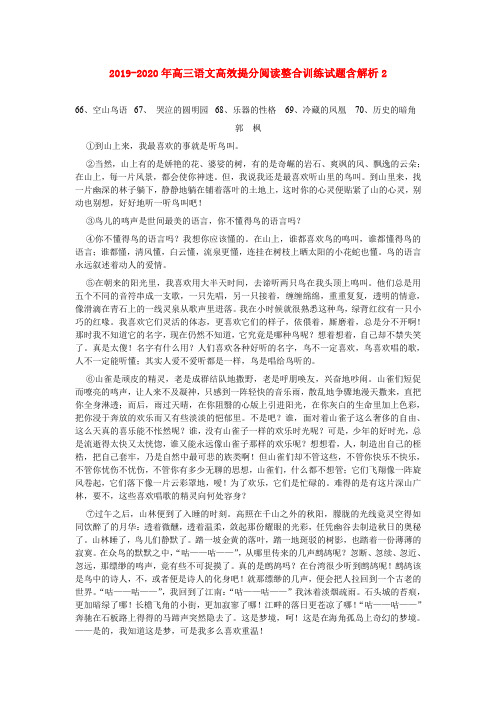
2019-2020年高三语文高效提分阅读整合训练试题含解析266、空山鸟语67、哭泣的圆明园68、乐器的性格69、冷藏的凤凰70、历史的暗角郭枫①到山上来,我最喜欢的事就是听鸟叫。
②当然,山上有的是娇艳的花、婆娑的树,有的是奇崛的岩石、爽飒的风、飘逸的云朵;在山上,每一片风景,都会使你神迷。
但,我说我还是最喜欢听山里的鸟叫。
到山里来,找一片幽深的林子躺下,静静地躺在铺着落叶的土地上,这时你的心灵便贴紧了山的心灵,别动也别想,好好地听一听鸟叫吧!③鸟儿的鸣声是世间最美的语言,你不懂得鸟的语言吗?④你不懂得鸟的语言吗?我想你应该懂的。
在山上,谁都喜欢鸟的鸣叫,谁都懂得鸟的语言;谁都懂,清风懂,白云懂,流泉更懂,连挂在树枝上晒太阳的小花蛇也懂。
鸟的语言永远叙述着动人的爱情。
⑤在朝来的阳光里,我喜欢用大半天时间,去谛听两只鸟在我头顶上鸣叫。
他们总是用五个不同的音符串成一支歌,一只先唱,另一只接着,缠缠绵绵,重重复复,透明的情意,像滑滴在青石上的一线灵泉从歌声里迸落。
我在小时候就很熟悉这种鸟,绿背红纹有一只小巧的红喙。
我喜欢它们灵活的体态,更喜欢它们的样子,依偎着,厮磨着,总是分不开啊!那时我不知道它的名字,现在仍然不知道,它究竟是哪种鸟呢?想着想着,自己却不禁失笑了。
真是太傻!名字有什么用?人们喜欢各种好听的名字,鸟不一定喜欢,鸟喜欢唱的歌,人不一定能听懂;其实人爱不爱听都是一样,鸟是唱给鸟听的。
⑥山雀是顽皮的精灵,老是成群结队地撒野,老是呼朋唤友,兴奋地吵闹。
山雀们短促而嘹亮的鸣声,让人来不及凝神,只感到一阵轻快的音乐雨,散乱地争骤地漫天撒来,直把你全身淋透;而后,雨过天晴,在你阻翳的心版上引进阳光,在你灰白的生命里加上色彩,把你浸于奔放的欢乐而又有些淡淡的悒郁里。
不是吧?谁,面对着山雀子这么奢侈的自由、这么天真的喜乐能不怅然呢?谁,没有山雀子一样的欢乐时光呢?可是,少年的好时光,总是流逝得太快又太恍惚,谁又能永远像山雀子那样的欢乐呢?想想看,人,制造出自己的桎梏,把自己套牢,乃是自然中最可悲的族类啊!但山雀们却不管这些,不管你快乐不快乐,不管你忧伤不忧伤,不管你有多少无聊的思想,山雀们,什么都不想管;它们飞翔像一阵旋风卷起,它们落下像一片云彩罩地,嗳!为了欢乐,它们是忙碌的。
托福TPO40阅读Passage2原文文本+题目+答案解析
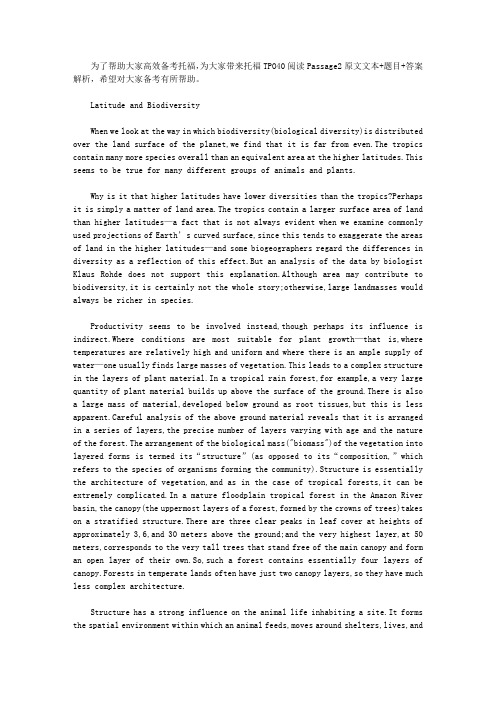
为了帮助大家高效备考托福,为大家带来托福TPO40阅读Passage2原文文本+题目+答案解析,希望对大家备考有所帮助。
Latitude and Biodiversity When we look at the way in which biodiversity(biological diversity)is distributed over the land surface of the planet,we find that it is far from even.The tropics contain many more species overall than an equivalent area at the higher latitudes.This seems to be true for many different groups of animals and plants. Why is it that higher latitudes have lower diversities than the tropics?Perhaps it is simply a matter of land area.The tropics contain a larger surface area of land than higher latitudes—a fact that is not always evident when we examine commonly used projections of Earth’s curved surface,since this tends to exaggerate the areas of land in the higher latitudes—and some biogeographers regard the differences in diversity as a reflection of this effect.But an analysis of the data by biologist Klaus Rohde does not support this explanation.Although area may contribute to biodiversity,it is certainly not the whole story;otherwise,large landmasses would always be richer in species. Productivity seems to be involved instead,though perhaps its influence is indirect.Where conditions are most suitable for plant growth—that is,where temperatures are relatively high and uniform and where there is an ample supply of water—one usually finds large masses of vegetation.This leads to a complex structure in the layers of plant material.In a tropical rain forest,for example,a very large quantity of plant material builds up above the surface of the ground.There is also a large mass of material,developed below ground as root tissues,but this is less apparent.Careful analysis of the above ground material reveals that it is arranged in a series of layers,the precise number of layers varying with age and the nature of the forest.The arrangement of the biological mass("biomass")of the vegetation into layered forms is termed its“structure”(as opposed to its“composition,”which refers to the species of organisms forming the community).Structure is essentially the architecture of vegetation,and as in the case of tropical forests,it can be extremely complicated.In a mature floodplain tropical forest in the Amazon River basin,the canopy(the uppermost layers of a forest,formed by the crowns of trees)takes on a stratified structure.There are three clear peaks in leaf cover at heights of approximately 3,6,and 30 meters above the ground;and the very highest layer,at 50 meters,corresponds to the very tall trees that stand free of the main canopy and form an open layer of their own.So,such a forest contains essentially four layers of canopy.Forests in temperate lands often have just two canopy layers,so they have much less complex architecture. Structure has a strong influence on the animal life inhabiting a site.It forms the spatial environment within which an animal feeds,moves around shelters,lives,andbreeds.It even affects the climate on a very local level(the"microclimate")by influencing light intensity,humidity,and both the range and extremes of temperature.An area of grassland vegetation with very simple structure,for example,has a very different microclimate at the ground level from that experienced in the upper canopy.Wind speeds are lower,temperatures are lower during the day(but warmer at night),and the relative humidity is much greater near the ground.The complexity of the microclimate is closely related to the complexity of structure in vegetation,and generally speaking,the more complex the structure of vegetation,the more species of animal are able to make a living there.The high plant biomass of the tropics leads to a greater spatial complexity in the environment,and this leads to a higher potential for diversity in the living things that can occupy a region.The climates of the higher latitudes are generally less favorable for the accumulation of large quantities of biomass;hence,the structure of vegetation is simpler and the animal diversity is consequently lower. paragraph 1 When we look at the way in which biodiversity(biological diversity)is distributed over the land surface of the planet,we find that it is far from even.The tropics contain many more species overall than an equivalent area at the higher latitudes.This seems to be true for many different groups of animals and plants. 1.The word“distributed”in the passage is closest in meaning to A.represented B.collected C.spread D.managed 2.The word“overall”in the passage is closest in meaning to A.considered as a whole B.to some degree C.possibly D.evidently paragraph 2。
闻怀沙高效阅读的读后感
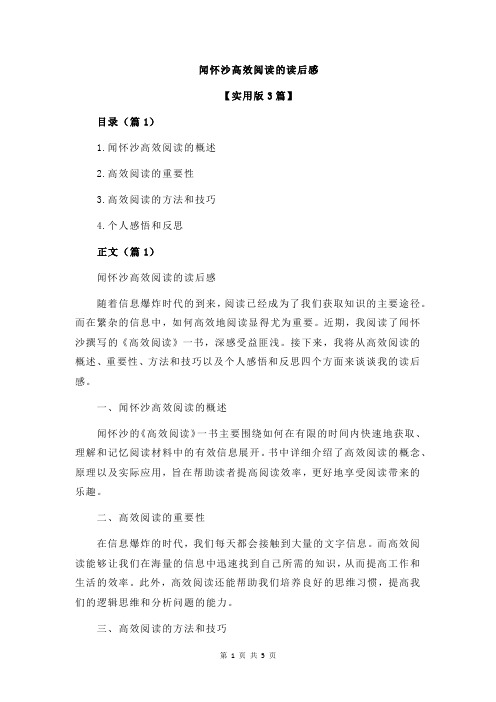
闻怀沙高效阅读的读后感【实用版3篇】目录(篇1)1.闻怀沙高效阅读的概述2.高效阅读的重要性3.高效阅读的方法和技巧4.个人感悟和反思正文(篇1)闻怀沙高效阅读的读后感随着信息爆炸时代的到来,阅读已经成为了我们获取知识的主要途径。
而在繁杂的信息中,如何高效地阅读显得尤为重要。
近期,我阅读了闻怀沙撰写的《高效阅读》一书,深感受益匪浅。
接下来,我将从高效阅读的概述、重要性、方法和技巧以及个人感悟和反思四个方面来谈谈我的读后感。
一、闻怀沙高效阅读的概述闻怀沙的《高效阅读》一书主要围绕如何在有限的时间内快速地获取、理解和记忆阅读材料中的有效信息展开。
书中详细介绍了高效阅读的概念、原理以及实际应用,旨在帮助读者提高阅读效率,更好地享受阅读带来的乐趣。
二、高效阅读的重要性在信息爆炸的时代,我们每天都会接触到大量的文字信息。
而高效阅读能够让我们在海量的信息中迅速找到自己所需的知识,从而提高工作和生活的效率。
此外,高效阅读还能帮助我们培养良好的思维习惯,提高我们的逻辑思维和分析问题的能力。
三、高效阅读的方法和技巧在《高效阅读》一书中,闻怀沙为我们提供了许多实用的高效阅读方法和技巧,主要包括以下几点:1.预览:在开始阅读之前,先快速浏览全文,了解文章的大致结构和主题内容,为接下来的阅读做好铺垫。
2.提问:在阅读过程中,尝试对自己提出一些问题,以激发自己的思考,更好地理解文章内容。
3.视觉阅读:尽量扩大自己的视觉跨度,一次阅读多个单词,提高阅读速度。
4.复述:阅读完成后,尝试用自己的话复述文章内容,以检验自己对文章的理解程度。
5.复习:定期复习所阅读的内容,巩固记忆,确保所学知识能够为我所用。
四、个人感悟和反思阅读完《高效阅读》一书后,我深刻地认识到自己在阅读方面存在的问题,并开始尝试运用书中提供的方法和技巧进行改进。
经过一段时间的实践,我发现自己的阅读效率确实得到了很大的提高。
然而,在实际应用过程中,我还需要不断地去调整和完善自己的阅读方法,以便更好地适应不同的阅读材料和场景。
托福TPO3阅读Passage2原文文本+题目+答案解析

为了帮助大家高效备考托福,为大家带来托福TPO3阅读Passage2原文文本+题目+答案解析,希望对大家备考有所帮助。
▉托福TPO3阅读Passage2原文文本: Depletion of the Ogallala Aquifer The vast grasslands of the High Plains in the central United States were settled by farmers and ranchers in the 1880s. This region has a semiarid climate, and for 50 years after its settlement, it supported a low-intensity agricultural economy of cattle ranching and wheat farming. In the early twentieth century, however, it was discovered that much of the High Plains was underlain by a huge aquifer (a rock layer containing large quantities of groundwater). This aquifer was named the Ogallala aquifer after the Ogallala Sioux Indians, who once inhabited the region. The Ogallala aquifer is a sandstone formation that underlies some 583,000 square kilometers of land extending from northwestern Texas to southern South Dakota. Water from rains and melting snows has been accumulating in the Ogallala for the past 30,000 years. Estimates indicate that the aquifer contains enough water to fill Lake Huron, but unfortunately, under the semiarid climatic conditions that presently exist in the region, rates of addition to the aquifer are minimal, amounting to about half a centimeter a year. The first wells were drilled into the Ogallala during the drought years of the early 1930s. The ensuing rapid expansion of irrigation agriculture, especially from the 1950s onward, transformed the economy of the region. More than 100,000 wells now tap the Ogallala. Modern irrigation devices, each capable of spraying 4. 5 million liters of water a day, have produced a landscape dominated by geometric patterns of circular green islands of crops. Ogallala water has enabled the High Plains region to supply significant amounts of the cotton, sorghum, wheat, and corn grown in the United States. In addition, 40 percent of American grain-fed beef cattle are fattened here. This unprecedented development of a finite groundwater resource with an almost negligible natural recharge rate—that is, virtually no natural water source to replenish the water supply—has caused water tables in the region to fall drastically. In the 1930s, wells encountered plentiful water at a depth of about 15 meters; currently, they must be dug to depths of 45 to 60 meters or more. In places, the water table is declining at a rate of a meter a year, necessitating the periodic deepening of wells and the use of ever-more-powerful pumps. It is estimated that at current withdrawal rates, much of the aquifer will run dry within 40 years. The situation is most critical in Texas, where the climate is driest, the greatest amount of water is being pumped, and the aquifer contains the least water. It is projected that the remaining Ogallala water will, by the year 2030, support only 35 to 40 percent ofthe irrigated acreage in Texas that is supported in 1980. The reaction of farmers to the inevitable depletion of the Ogallala varies. Many have been attempting to conserve water by irrigating less frequently or by switching to crops that require less water. Others, however, have adopted the philosophy that it is best to use the water while it is still economically profitable to do so and to concentrate on high-value crops such as cotton. The incentive of the farmers who wish to conserve water is reduced by their knowledge that many of their neighbors are profiting by using great amounts of water, and in the process are drawing down the entire region’s water supplies. In the face of the upcoming water supply crisis, a number of grandiose schemes have been developed to transport vast quantities of water by canal or pipeline from the Mississippi, the Missouri, or the Arkansas rivers. Unfortunately, the cost of water obtained through any of these schemes would increase pumping costs at least tenfold, making the cost of irrigated agricultural products from the region uncompetitive on the national and international markets. Somewhat more promising have been recent experiments for releasing capillary water (water in the soil) above the water table by injecting compressed air into the ground. Even if this process proves successful, however, it would almost triple water costs. Genetic engineering also may provide a partial solution, as new strains of drought-resistant crops continue to be developed. Whatever the final answer to the water crisis may be, it is evident that within the High Plains, irrigation water will never again be the abundant, inexpensive resource it was during the agricultural boom years of the mid-twentieth century. ▉托福TPO3阅读Passage2题目: Question 1 of 14 According to paragraph 1, which of the following statements about the High Plains is true? A. Until farmers and ranchers settled there in the 1880s, the High Plains had never been inhabited.. B. The climate of the High Plains is characterized by higher-than-average temperatures.. C. The large aquifer that lies underneath the High Plains was discovered by the Ogallala Sioux Indians.. D. Before the early 1900s there was only a small amount of farming and ranching in the High Plains..。
阅读材料2
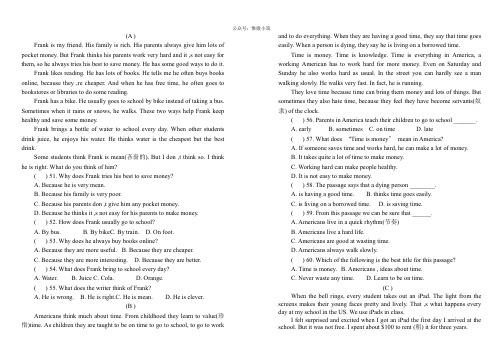
(A )Frank is my friend. His family is rich. His parents always give him lots of pocket money. But Frank thinks his parents work very hard and it ,s not easy for them, so he always tries his best to save money. He has some good ways to do it.Frank likes reading. He has lots of books. He tells me he often buys books online, because they ,re cheaper. And when he has free time, he often goes to bookstores or libraries to do some reading.Frank has a bike. He usually goes to school by bike instead of taking a bus. Sometimes when it rains or snows, he walks. These two ways help Frank keep healthy and save some money.Frank brings a bottle of water to school every day. When other students drink juice, he enjoys his water. He thinks water is the cheapest but the best drink.Some students think Frank is mean(吝啬的). But I don ,t think so. I think he is right. What do you think of him?( ) 51. Why does Frank tries his best to save money?A. Because he is very mean.B. Because his family is very poor.C. Because his parents don ,t give him any pocket money.D. Because he thinks it ,s not easy for his parents to make money.( ) 52. How does Frank usually go to school?A. By bus.B. By bikeC. By train.D. On foot.( ) 53. Why does he always buy books online?A. Because they are more useful.B. Because they are cheaper.C. Because they are more interesting.D. Because they are better.( ) 54. What does Frank bring to school every day?A. Water.B. JuiceC. Cola.D. Orange.( ) 55. What does the writer think of Frank?A. He is wrong.B. He is right.C. He is mean.D. He is clever.(B )Americans think much about time. From childhood they learn to value(珍惜)time. As children they are taught to be on time to go to school, to go to work and to do everything. When they are having a good time, they say that time goes easily. When a person is dying, they say he is living on a borrowed time.Time is money. Time is knowledge. Time is everything in America, a working American has to work hard for more money. Even on Saturday and Sunday he also works hard as usual. In the street you can hardly see a man walking slowly. He walks very fast. In fact, he is running.They love time because time can bring them money and lots of things. But sometimes they also hate time, because they feel they have become servants(奴隶) of the clock.( ) 56. Parents in America teach their children to go to school _______.A. earlyB. sometimesC. on timeD. late( ) 57. What does "Time is money〞mean in America?A. If someone saves time and works hard, he can make a lot of money.B. It takes quite a lot of time to make money.C. Working hard can make people healthy.D. It is not easy to make money.( ) 58. The passage says that a dying person ________.A. is having a good time.B. thinks time goes easily.C. is living on a borrowed time.D. is saving time.( ) 59. From this passage we can be sure that ______.A. Americans live in a quick rhythm(节奏)B. Americans live a hard life.C. Americans are good at wasting time.D. Americans always walk slowly.( ) 60. Which of the following is the best title for this passage?A. Time is money.B. Americans , ideas about time.C. Never waste any time.D. Learn to be on time.(C )When the bell rings, every student takes out an iPad. The light from the screens makes their young faces pretty and lively. That ,s what happens every day at my school in the US. We use iPads in class.I felt surprised and excited when I got an iPad the first day I arrived at the school. But it was not free. I spent about $100 to rent (租) it for three years.Every iPad at my school has a special learning system (系统)called Focus. Teachers put their teaching materials like textbooks and PPTs on it. When we have classes, we enter the system and download the materials with our iPads.It makes the classes interesting and efficient (高效的). For example, a few weeks ago, we learned about London in the UK. Our teacher prepared a video in which we saw many places of interest in London. We could not only watch the video, but also see the words at the same time. Because of the video, I know more about the city.We also do our homework with iPads. We can know how well we do our homework right after we submit (提交) our homework.However, there are still some bad points about learning with iPads. Some of my classmates play games or surf the Internet in class.I believe the key to use iPads well is to have good self -control (自制), isn ,t it?( ) 61. In the writer ,s class, every student ________.A. gets a free iPad from the teacherB. plays games on iPads in each classC. shares an iPad with their classmates in classD. rents an iPad to use at school for three years( ) 62. The underlined word "Focus〞is ________.A. a special learning systemB. PPTs and videosC. teachers , teaching materialsD. the name of the iPad at school( ) 63. When students are learning with iPads, they should not _______.A. play gamesB. watch some videosC. download the materialsD. submit the homework( ) 64. According to the example in Paragraph 4, we learn that _______.A. students don ,t like to use iPads in classB. iPads are not useful when having classesC. students use iPads to watch videos every classD. iPads make the classes interesting and efficient( ) 65. What does the writer think of using iPads in school?A. Students should use iPads as often as possible.B. To use iPads in school is very bad for students , eyes.C. Students should have good self -control when using iPads.D. All students should use iPads to surf the Internet in class.A.April B.May C.June D.July( )47.What can you do at 9:00 am if you go to the summer camp?A.To have a tour. B.To watch evening programmes.C.To have a conversation. D.To learn writing.( )48.How long does the programme "the English Conversation Skills〞last?A.2.5hours. B.1.5hours. C.More than three hours. D.Two hours. ( )49.If you want to get more information about the camp, you can .A.give a phone call B.write a letterC.send an email D.surf the Internet( )50.Which of the following is NOT true?A.Evening Programmes in the camp last two hours.B.In the camp you can both learn English and do sports.C.You must get up at 7:30 am every morning in the camp.D.You may do sports at 5:00 pm.BJamie was born in a small village in north of England. He is ten years old. He likes playing basketball very much. When he is free, he always plays basketball with his friends in the open air. Sometimes he walks in the forest and picks some flowers by himself.Last Friday, Jamie finished his homework after the second class in the morning. He hurried to play basketball. The playground was wet. After some time, his basketball was dirty and his hands were dirty, too. It was 9:45 and thethird class began. Jamie had no time to wash his hands and ran into his classroom. Mr. Black, his English teacher, told Jamie to write some new words on the blackboard. Jamie stood in front of the blackboard and started to write. Mr. Black saw his right hand was dirty."Oh, dear!〞said the teacher. "Your right hand is dirty. I ,m sure it ,s the dirtiest in our class.〞"You are wrong, Mr. Black,〞said Jamie. Then he showed his left hand and it was dirtier.( ) 51. From the first paragraph (段), we know Jamie _________.A. was born in 2005B. likes playing footballC. doesn ,t like flowersD. lives in the south of England( ) 52. When did Jamie play basketball last Friday?A. After the first class.B. After the third class.C. Between the first class and the second class.D. Between the second class and the third class.( ) 53. Jamie ,s hands were dirty last Friday because ________.A. the playground was wet.B. he picked flowers in the morningC. he has no habit of washing his handsD. there was no water to wash his hands( ) 54. Mr. Black asked Jamie to _________.A. wash his handsB. write some wordsC. show his right handD. show his left hand( )55. What ,s the best title(题目) for the passage?A. Where Are You From?B. Can You Play Basketball?C. You Are WrongD. I ,m SorryCTFBOYS is a young singing group of China. There are three members in it. Wang Junkai, 16, and Wang Yuan, 15, are from Chongqing, and Yi Yangqianxi, 15, is from Hunan. They are all good at singing and dancing.During the weekdays, the three boys go to school and study like other kids. But during the weekends, they have to practice singing and dancing. It is not easy, but the three boys do it well. What ,s more, they are all top students at school."We try our best to put study before everything,〞said Wang Junkai. He just entered Chongqing No. 8 High School. It is a key (重点的) school.Yi is also a very good student. He has a busy life. Besides training, he also acts in movies and TV shows. But he still did very well in calligraphy (书法) competitions. How can he be good at so many things? "I always practice dancing while others are playing,〞he said.Many people say that TFBOYS becomes popular only because of their cute looks. But I don ,t think so. They always work hard for their music dreams. That ,s why so many people like them.( )56. How old is Wang Y uan?A. 14.B. 15.C. 16D. 17.( )57. What do they usually do on weekends?A. They go to school.B. They act in TV shows.C. They have a rest.D. They practice singing and dancing.( )58. What do Y ,s words mean?A. Everything is as important as study.B. We should work hard to do everything.C. Singing is the most important thing.D. Dancing is more important than playing.( )59. Why can Yi Yangqianxi be good at so many things?A. Because he always works hard.B. Because he is very lucky.C. Because many people help him.D. Because he is talented.( )60. Which of the following is TRUE according to the passage?A. Wang Yuan and Yi Yangqianxiare the same age.B. The three boys all study at key schools.C. Yi Yangqianxi spends much time instudying English.(A )My grandfather Jack is 96 years old ,and he has had an interesting life. He has travelled a lot in his life in the Far East. He visited the Taj Mahal in India and the Pyramids in Egypt. He hunted (狩猎)lions in Africa, and rode a camel in the Sahara Desert. He says the most beautiful place he has travelled to is Kathmandu in Nepal.Jack has married twice. His first wife died when she was 32. He met his second wife Maria while he was cycling round France. They have beenmarried for 50 years, and they have lived happily in a small village since they got married.Jack says that he has never been ill in his life. The secret of good health, according to my grandfather, is exercise. He goes swimming every morning. He has done this since he was a boy. He also has a glass of wine every night !Perhaps that is his secret !( ) 51.What kind of life has Jack lived?A. A short life.B. An interesting life.C. A lonely life.D. A poor life.( ) 52.Which of the following does Jack think is the most beautiful place?A. Kathmandu.B. The Pyramids.C.The Sahara Desert.D.Taj Mahal.( ) 53. How many times has Jack married?A. Once.B. Twice.C. Three times.D. Four times.( ) 54.Where did Jack meet Maria?A.In India.B.In Nepal.C. In France.D.In Egypt.( ) 55.What does Jack do every night?A. He has a glass of wine.B. He goes swimming.C. He hunts lions.D. He rides a camel.( B )When I was 13 years old, a girl gave me an important gift. It was a smile. It was the early autumn of my first year at a junior high school, and my old school was far away. As a result, no one knew who I was. I was very lonely, and afraid to make friends with anyone. Every time I heard the other students talking and laughing, I felt even more lonely. I couldn ,t talk to anyone about my problem, and I didn ,t want my parents to worry about me. Then one day, my classmates were talking with their friends, but I sat in silence. At that moment, a girl entered the classroom. I didn ,t know who she was, she passed me and then turned back. She looked at me and, without a word, smiled. Suddenly, I felt the touch of something bright and friendly. It made me feel happy, lively and warm. It was like a hidden treasure.That smile changed my life. I started to talk with the other students and made friends. Day by day, I learnt to trust people, and they included me in their circle of friends. The girl with the bright smile has become my best friend now, and we stick together like glue. One day, I asked her why she smiled at me, she said she could not remember!Now I believe that the world is what you think it is. If you think you are lonely, you might always be alone. So smile at the world and it will smile back.( )56. Why was the smile an important gift to the author(作者)? BecauseA. her old school was far away.B. she didn ,t know who the girl was.C. it made her feel happy and warm.D. the smile didn ,t mean anything to the girl.( ) 57. Why couldn ,t the author talk to anyone about her problem at school?BecauseA. she didn ,t want to worry about her parents.B. she didn ,t have any friends in her new school.C. she was in the first year at a junior high school.D. she was always unhappy.( ) 58. How did the smile change the author ,s life?A. She began to make friends.B. She became best friends with the girl.C. Her parents didn ,t worry about her any more.D. She started to work hard.( ) 59. Where does the author now think her feeling of unhappiness came from?A. From her old school.B. From other people in the world.C. From herself.D. From the children at the new school.( ) 60. From the passage, we know that the girl with the bright smile was .A. lonelyB. aloneC. smartD. friendlyA.personB.schoolC.Chinese courseD.summer camp( ) 62. The new summer camp will last for.A. half a monthB. twenty -two daysC.one monthD.two months( ) 63.If you want to take part in the new summer camp,you can call at .A.56791830.B. 62187038.C.62197830.D.57917380.( ) 64.The new summer camp mainly gives children a chance to enjoy .A.Chinese moviesB.some paintingsC.Chinese cultureD.some sports( ) 65.You can get more information about the new summer camp by. A.making a call B.sending an emailC.visiting the website D.all the aboveADifferent people have different ideas about time. People in the USA think that it is important to know the time. In cities in America, there are clocks in stations, factories and other buildings. Radio tells the correct time during the day. Most Americans also have watches with them wherever they go. They want to do certain things at certain time. They don ,t like to be late.But time is not so important to everybody in the world. When you visit a country in South America, you will find that people there don ,t like to rush. If you had an appointment with somebody, he could probably be late, because he may not want to arrive on time.In South America, even the radio program may not begin on time. The men on the radio may not think it is important to tell the exact time. People in South America think that clocks or watches are just machines. They think that you let a clock or a watch control your life if you do everything on time.56. Time is very important to ________.A. people in AmericaB. people in South AmericaC. the men on the radioD. everybody in the world57. The underlined word "appointment〞probably means ________ in Chinese.A. 方案B. 见面C. 等待D. 采访58. People in South America think ________.A. they wouldn ,t like to meet friends in public placesB. they don ,t have to do certain things at certain timeC. it ,s wrong of a radio station to tell wrong timeD. it ,s their habit to be a little earlier59. If you meet up with somebody in South America, ________.A. you must arrive on timeB. he may not arrive on timeC. he has to rush to meet youD. you must know time is important to him60. What is the best title of the passage?A. Is your life relaxing?B. Must radio tell the exact time?C. Different people have different ideas about time.D. Differences between North and South America are everywhere.。
高效阅读训练ppt (2)

高效阅读的定义
快速理解
高效阅读不仅仅是速度快,更重要的是理 解和吸收信息的能力。
筛选信息
根据阅读目的筛选关键信息,忽略无关紧 要的内容,节省阅读时间。
集中注意力
在阅读时保持专注,避免分散注意力,有 助于提高阅读效率。
笔记与总结
通过做笔记或总结,加深对阅读内容的理 解和记忆。
创造性阅读
总结:创造性阅读是指读者在阅读过程中发挥想象力,从不同角度解读文本,发现新的意义和价值。
在创造性阅读中,读者需要摆脱传统的思维模式和框架,尝试从不同的角度和维度来理解文本。例如 ,可以从文本中的某个细节出发,展开联想和想象,构建出新的故事或观点。创造性阅读有助于激发 读者的创造力和想象力,培养其创新思维和解决问题的能力。
创造阅读环境
选择一个安静、舒适的环 境,有助于集中注意力, 提高阅读效率。
阅读速度的提高
扩大视幅
通过训练扩大眼睛每次注视的视幅,提高阅读速 度。
减少回视
培养一次读懂、读透的习惯,减少不必要的回视, 提高阅读速度。
限时阅读
通过限制阅读时间,提高阅读速度和效率。
阅读质量的提高
理解与思考
在阅读过程中注重理解和思考,有助于深入理解文本内容。
注重细节
在阅读过程中注重细节, 如关键词、句子结构、段 落结构等,有助于更好地 理解文章内容。
THANKS
感谢观看
阅读训练可以结合其他学 习方式,如笔记、总结等, 提高学习效果。
阅读训练建议
制定阅读计划
制定明确的阅读计划,包 括阅读目标、阅读材料、 阅读时间等,有助于提高 阅读效率。
多样化阅读材料
五年级阅读练习册2
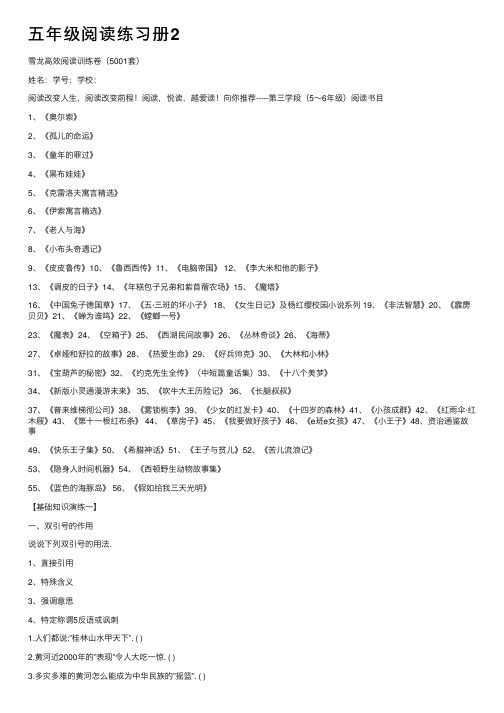
五年级阅读练习册2雪龙⾼效阅读训练卷(5001套)姓名:学号:学校:阅读改变⼈⽣,阅读改变前程!阅读,悦读,越爱读!向你推荐-----第三学段(5~6年级)阅读书⽬1、《奥尔索》2、《孤⼉的命运》3、《童年的罪过》4、《⿊布娃娃》5、《克雷洛夫寓⾔精选》6、《伊索寓⾔精选》7、《⽼⼈与海》8、《⼩布头奇遇记》9、《⽪⽪鲁传》10、《鲁西西传》11、《电脑帝国》 12、《李⼤⽶和他的影⼦》13、《调⽪的⽇⼦》14、《年糕包⼦兄弟和紫苜蓿农场》15、《魔塔》16、《中国兔⼦德国草》17、《五·三班的坏⼩⼦》 18、《⼥⽣⽇记》及杨红缨校园⼩说系列 19、《⾮法智慧》20、《霹雳贝贝》21、《蝉为谁鸣》22、《螳螂⼀号》23、《魔表》24、《空箱⼦》25、《西湖民间故事》26、《丛林奇谈》26、《海蒂》27、《卓娅和舒拉的故事》28、《热爱⽣命》29、《好兵帅克》30、《⼤林和⼩林》31、《宝葫芦的秘密》32、《约克先⽣全传》(中短篇童话集)33、《⼗⼋个美梦》34、《新版⼩灵通漫游未来》 35、《吹⽜⼤王历险记》 36、《长腿叔叔》37、《普来维梯彻公司》38、《雾锁桃李》39、《少⼥的红发卡》40、《⼗四岁的森林》41、《⼩孩成群》42、《红⾬伞·红⽊屐》43、《第⼗⼀根红布条》 44、《草房⼦》45、《我要做好孩⼦》46、《e班e⼥孩》47、《⼩王⼦》48、资治通鉴故事49、《快乐王⼦集》50、《希腊神话》51、《王⼦与贫⼉》52、《苦⼉流浪记》53、《隐⾝⼈时间机器》54、《西顿野⽣动物故事集》55、《蓝⾊的海豚岛》 56、《假如给我三天光明》【基础知识演练⼀】⼀、双引号的作⽤说说下列双引号的⽤法.1、直接引⽤2、特殊含义3、强调意思4、特定称谓5反语或讽刺1.⼈们都说:”桂林⼭⽔甲天下”. ( )2.黄河近2000年的”表现”令⼈⼤吃⼀惊. ( )3.多灾多难的黄河怎么能成为中华民族的”摇篮”. ( )4.⿁⼦来”扫荡”了. ( )5.爸爸⼀定送你⼀顶”蓝盔”( )6.我看见了”⾬后春笋”的画⾯. ( )7.荷兰有”欧洲花园”,”花卉王国”的美誉. ( )8.⼤家采集”茅茅针”. ( )9.说”认识”,其实我并不理解他. ( )10.说他”特别”,因为他爱鱼到了忘我的境界. ( )11.罪恶的⼦弹还在威胁着娇嫩的”和平之花”. ( )12.说他”特别”,因为他爱鱼到了忘我的境界. ( )13.他在学校念书的时候,同学们就称他为”辩论家”. ( )14.巨兽和⼩鸟从表⾯看来,它们之间是”⽔⽕不相容”. ( )15.百⾆鸟和⾦黄⿏是⼀对”好朋友”. ( )16.号称”世界屋脊”的青藏⾼原,有两个世界之最. ( )17.那”鸟有天堂”的确是鸟的天堂. ( )18.巨⼈竖起⼀块”禁⽌⼊内”的告⽰牌.( )19.家乡有⼀句”紧⾛搭⽯慢过桥”的俗语. ( )⼆、给下列句⼦合适的标点,注意引号的使⽤。
三年级语文上册阅读高校训练 专题二 句子的理解与运用(含答案)人教统编版
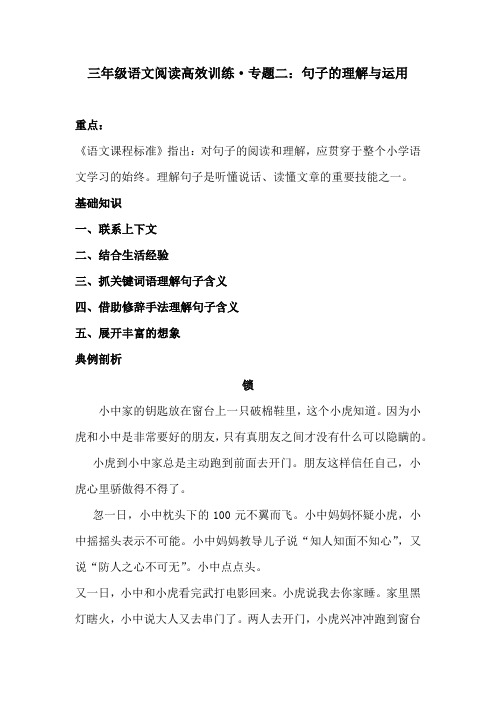
三年级语文阅读高效训练·专题二:句子的理解与运用重点:《语文课程标准》指出:对句子的阅读和理解,应贯穿于整个小学语文学习的始终。
理解句子是听懂说话、读懂文章的重要技能之一。
基础知识一、联系上下文二、结合生活经验三、抓关键词语理解句子含义四、借助修辞手法理解句子含义五、展开丰富的想象典例剖析锁小中家的钥匙放在窗台上一只破棉鞋里,这个小虎知道。
因为小虎和小中是非常要好的朋友,只有真朋友之间才没有什么可以隐瞒的。
小虎到小中家总是主动跑到前面去开门。
朋友这样信任自己,小虎心里骄傲得不得了。
忽一日,小中枕头下的100元不翼而飞。
小中妈妈怀疑小虎,小中摇摇头表示不可能。
小中妈妈教导儿子说“知人知面不知心”,又说“防人之心不可无”。
小中点点头。
又一日,小中和小虎看完武打电影回来。
小虎说我去你家睡。
家里黑灯瞎火,小中说大人又去串门了。
两人去开门,小虎兴冲冲跑到窗台前,棉鞋里却是空的。
小中从墙缝里抠出钥匙,说:“换地方了。
”说完,脸突然一热。
这一夜,小虎不停地翻身。
打这以后就不找小中玩了。
后来知道,100元是小侄儿偷偷拿走的,小中想找小虎解释,又不知道如何开口。
两人再见面,生分许多,只像一般熟人打了一个招呼。
那以后,两人心里都挂上了一把锁。
1.小虎和小中关系发生变化的起因是什么?用自己的话说一说。
___________________________________________________________ ___________________________________________________________2.小虎在小中家睡,不停翻身的原因是()A.没有困意睡不着觉B.后悔在小中家睡觉C.琢磨小中脸红的原因D.小中不信任自己,作为朋友很难过3.“那以后,两人心里都挂上了一把锁。
”这句话是什么意思?请结合生活经验谈谈你的理解。
___________________________________________________________ ___________________________________________________________参考答案1、小中妈妈放在枕头下的100元不明原因地丢了。
- 1、下载文档前请自行甄别文档内容的完整性,平台不提供额外的编辑、内容补充、找答案等附加服务。
- 2、"仅部分预览"的文档,不可在线预览部分如存在完整性等问题,可反馈申请退款(可完整预览的文档不适用该条件!)。
- 3、如文档侵犯您的权益,请联系客服反馈,我们会尽快为您处理(人工客服工作时间:9:00-18:30)。
好梦何必成真
周国平
①好梦成真--这是现在流行的一句祝词,人们以此互相慷慨地表达友善之意。
每当听见这话,我就不禁思忖:好梦都能成真,都非要成真吗?
②有两种不同的梦。
③第一种梦,它的内容是实际的,譬如说,梦想升官发财,梦想娶一个倾国倾城的美人或嫁一个富甲天下的款哥,梦想得诺贝尔奖金,等等。
对于这些梦,弗洛伊德的定义是适用的:梦是未实现的愿望的替代。
未实现不等于不可能实现,世上的确有人升了官发了财,娶了美人或嫁了富翁,得了诺贝尔奖金。
这种梦的价值取决于能否变成现实,如果不能,我们就说它是不切实际的梦想。
④第二种梦,它的内容与实际无关,因而不能用能否变成现实来衡量它的价值。
譬如说,陶渊明梦见桃花源,鲁迅梦见好的故事,但丁梦见天堂,或者作为普通人的我们梦见一片美丽的风景。
这种梦不能实现也不需要实现,它的价值在其自身,做这样的梦本身就是享受,而记载了这类梦的《桃花源记》、《好的故事》、《神曲》本身便成了人类的精神财富。
⑤所谓好梦成真往往是针对第一种梦发出的祝愿,我承认有其合理性。
一则古代故事描绘了一个贫穷的樵夫,说他白天辛苦打柴,夜晚大做其富贵梦,奇异的是每晚的梦像连续剧一样向前推进,最后好像是当上了皇帝。
这个樵夫因此过得十分快活,他的理由是:倘若把夜晚的梦当成现实,把白天的现实当成梦,他岂不就是天下最幸福的人。
这种自欺的逻辑遭到了当时人的哄笑,我相信我们今天的人也多半会加入哄笑的行列。
⑥可是,说到第二种梦,情形就很不同了。
我想把这种梦的范围和含义扩大一些,举凡组成一个人的心灵生活的东西,包括生命的感悟,艺术的体验,哲学的沉思,宗教的信仰,都可归入其中。
这样的梦永远不会变成看得见摸得着的直接现实,在此意义上不可能成真。
但也不必在此意义上成真,因为它们有着与第一种梦完全不同的实现方式,不妨说,它们的存在本身就已经构成了一种内在的现实,这样的好梦本身就已经是一种真。
对真的理解应该宽泛一些,你不能说只有外在的荣华富贵是真实的,内在的智慧教养是虚假的。
一个内心生活丰富的人,与一个内心生活贫乏的人,他们是在实实在在的意义上过着截然不同的生活。
⑦我把第一种梦称做物质的梦,把第二种梦称做精神的梦。
不能说做第一种梦的人庸俗,但是,如果一个人只做物质的梦,从不做精神的梦,说他庸俗就不算冤枉。
如果整个人类只梦见黄金而从不梦见天堂,则即使梦想成真,也只是生活在铺满金子的地狱里而已。
(选自周国平散文集《安静》,略有改动)
1、文章题目
2、文章作者
3、文章体裁
4、文章出处
5、作者在本文中表达的主要观点是什么?(答案不超过10个字)答:
6、第⑤段中,作者引用古代樵夫的故事有什么作用?
7、作者论述的“第二种梦”的含义是什么?
8、文章主要采用了的论证方法。
9、文章议论的结构模式是
10、结合全文,揣摩加点词语,谈谈你对文章末句的理解:
好梦何必成真》答案
5、好梦不必成真(或:好梦不一定成真、好梦何必成真)
6、为了论证第一种梦(物质的梦)的价值取决于能否变成现实,否则就成为不切实际的梦想,甚至遭人哄笑。
7、举凡组成一个人的心灵生活的东西(包括生命的感悟,艺术的体验,哲学的沉思,宗教的信仰,都可以归入其中)。
8、举例论证、对比论证
9、总——分——总
10、(黄金喻指富裕的物质生活,天堂喻指丰富的精神生活。
)人类若是只追求物质的享受,放弃了对精神生活的追求,内心世界将变得荒芜贫乏,荣华富贵将成为心灵的囚牢。
